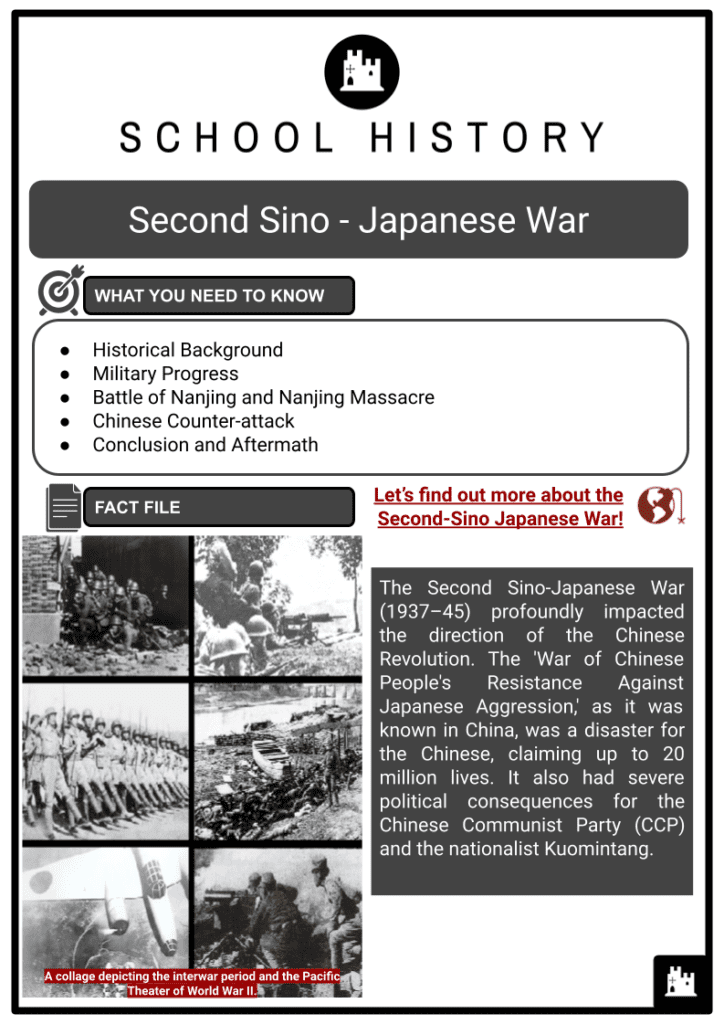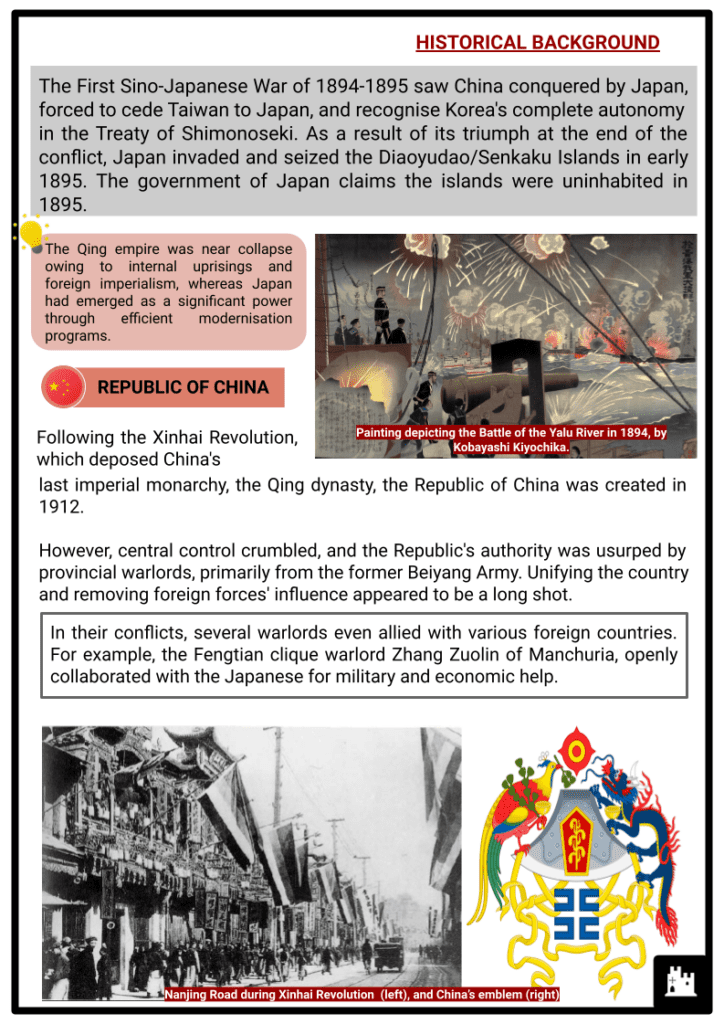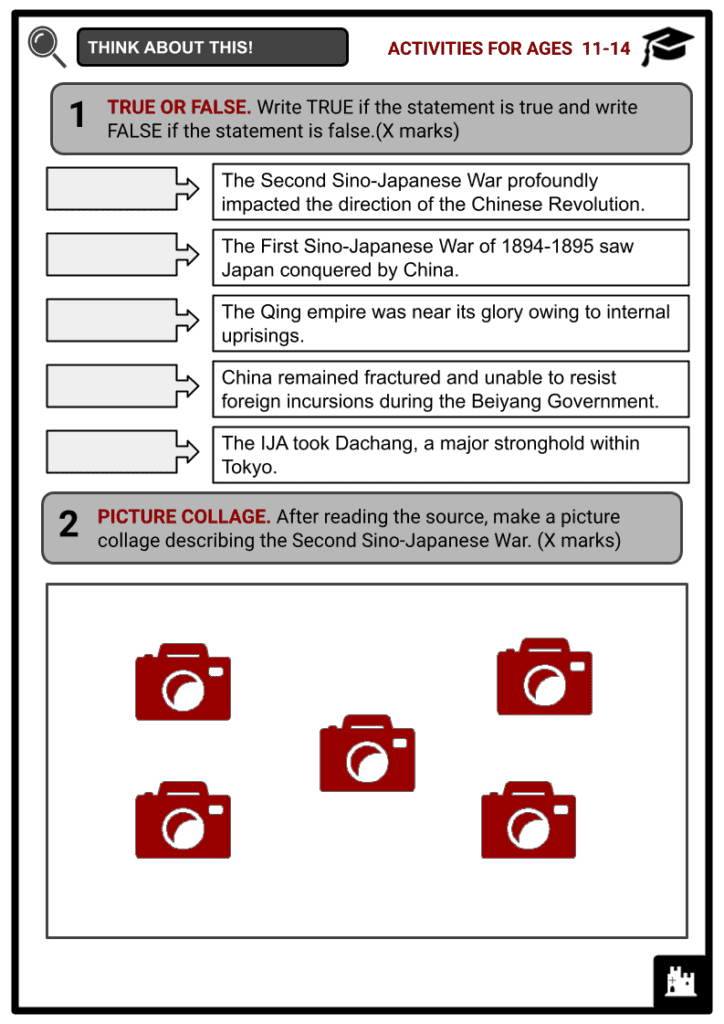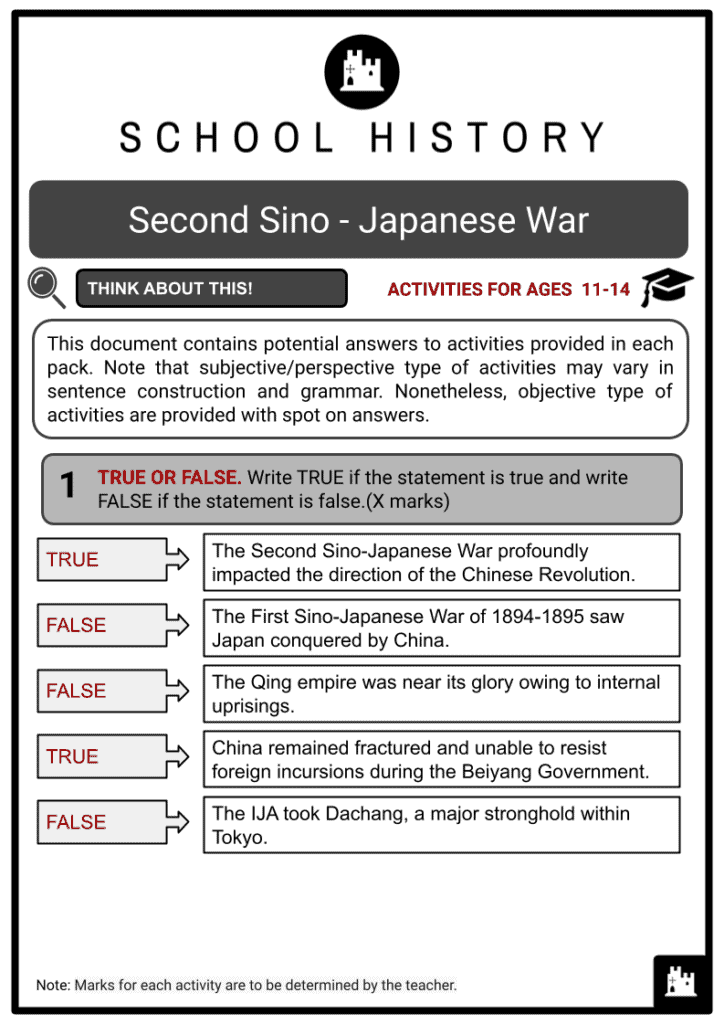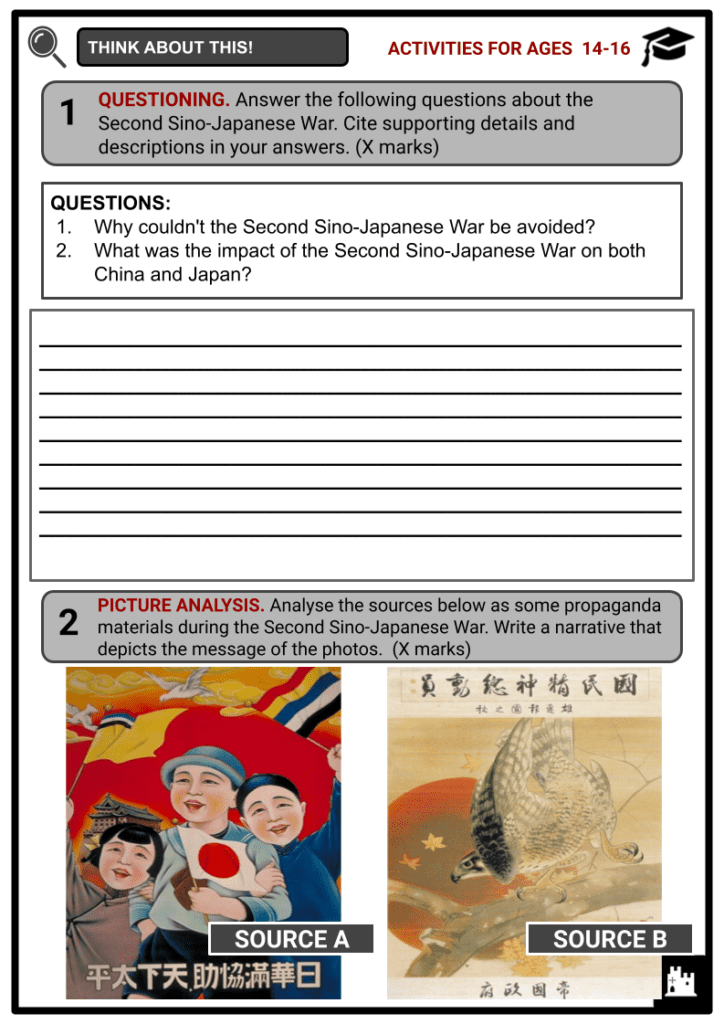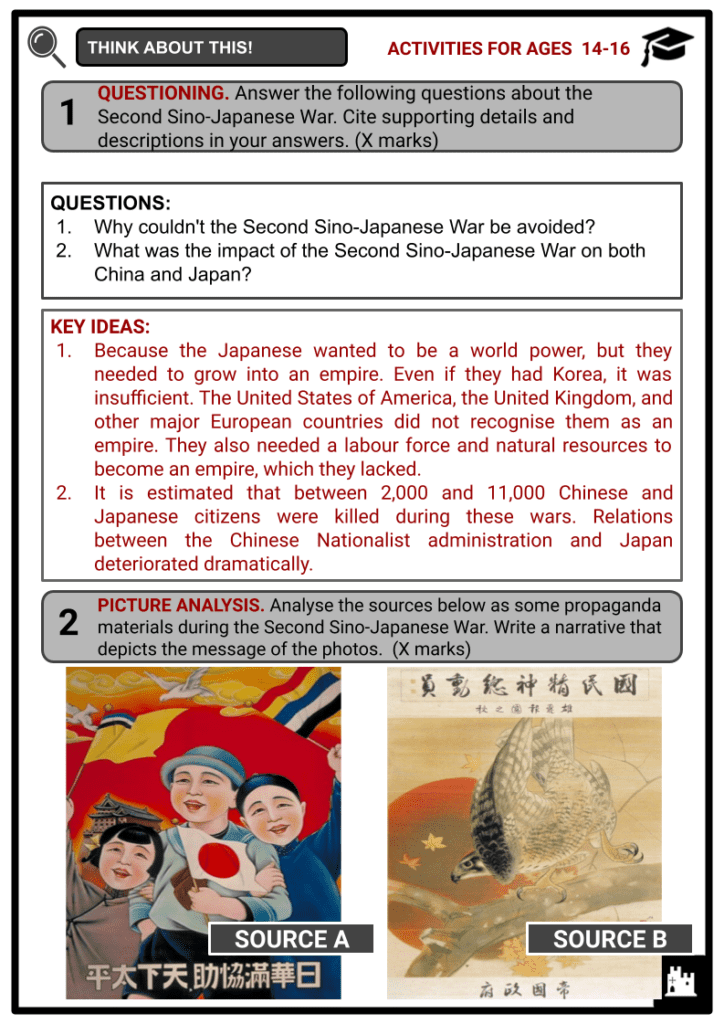Second Sino-Japanese War Worksheets
Do you want to save dozens of hours in time? Get your evenings and weekends back? Be able to teach about Second Sino-Japanese War to your students?
Our worksheet bundle includes a fact file and printable worksheets and student activities. Perfect for both the classroom and homeschooling!
Summary
- Historical Background
- Military Progress
- Battle of Nanjing and Nanjing Massacre
- Chinese Counter-attack
- Conclusion and Aftermath
Key Facts And Information
Let’s find out more about the Second Sino-Japanese War!
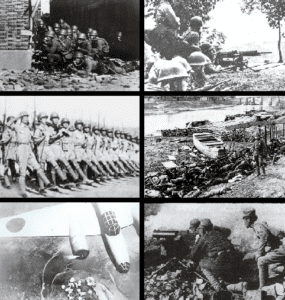
The Second Sino-Japanese War (1937–45) profoundly impacted the direction of the Chinese Revolution. The 'War of Chinese People's Resistance Against Japanese Aggression,' as it was known in China, was a disaster for the Chinese, claiming up to 20 million lives. It also had severe political consequences for the Chinese Communist Party (CCP) and the nationalist Kuomintang.
HISTORICAL BACKGROUND
- The First Sino-Japanese War of 1894-1895 saw China conquered by Japan, forced to cede Taiwan to Japan, and recognise Korea's complete autonomy in the Treaty of Shimonoseki. As a result of its triumph at the end of the conflict, Japan invaded and seized the Diaoyudao/Senkaku Islands in early 1895. The government of Japan claims the islands were uninhabited in 1895.
- The Qing empire was near collapse owing to internal uprisings and foreign imperialism, whereas Japan had emerged as a significant power through efficient modernisation programs.
REPUBLIC OF CHINA
- Following the Xinhai Revolution, which deposed China's last imperial monarchy, the Qing dynasty, the Republic of China was created in 1912. However, central control crumbled, and the Republic's authority was usurped by provincial warlords, primarily from the former Beiyang Army. Unifying the country and removing foreign forces' influence appeared to be a long shot.
- In their conflicts, several warlords even allied with various foreign countries. For example, the Fengtian clique warlord Zhang Zuolin of Manchuria, openly collaborated with the Japanese for military and economic help.
TWENTY ONE DEMANDS
- Japan presented the Twenty-One Demands in 1915 to wring additional political and commercial privileges from China, to which Yuan Shikai agreed. Following World War I, Japan took over the German Empire's sphere of influence in Shandong province, resulting in widespread anti-Japanese riots and massive rallies throughout China.
- China remained fractured and unable to resist foreign incursions during the Beiyang Government. From 1926 to 1928, the Kuomintang in Guangzhou conducted the Northern Expedition with minimal aid from the Soviet Union to unify China and defeat regional warlords. The Twenty-One Demands were a collection of demands presented to the government of the Republic of China by the Empire of Japan under Prime Minister Kuma Shigenobu during World War I.
REUNIFICATION OF CHINA
- Zhang Zuolin opted to retire back to Manchuria as the National Revolutionary Army approached Beijing before being murdered by the Kwantung Army in 1928. Zhang Xueliang, his son, took over as leader of the Fengtian clique in Manchuria. Later that year, Zhang pledged his loyalty to Chiang Kai-Nationalist Shek's government in Nanjing, and China was ostensibly reunified under one administration.
1929 SINO-SOVIET WAR
- The battle over the Chinese Eastern Railroad (CER) from July to November 1929 heightened tensions in the Northeast, leading to the Mukden Incident and, subsequently, the Second Sino-Japanese War.
- The Soviet Red Army won over Zhang Xueliang's forces re-established Soviet dominance over the CER in Manchuria and showed Chinese military shortcomings that Japanese Kwantung Army officers were quick to point out.
- The prowess of the Soviet Red Army astounded the Japanese as well. Japan's East Asian policy was centred on Manchuria, and Japan's determination to dominate the Northeast was reaffirmed at the Imperial Eastern Region Conferences in 1921 and 1927.
- The Red Army's triumph in 1929 shocked that doctrine to its core, reopening the Manchurian dilemma. By 1930, the Kwantung Army had realised they were up against a Red Army that was only getting stronger. The time had come to act, and Japanese plans to capture the Northeast had been hastened.
CHINESE COMMUNIST PARTY
- In 1930, the Central Plains War broke out in China between provincial leaders who had fought with the Kuomintang during the Northern Expedition and the Nanjing government led by Chiang. After the Shanghai massacre in 1927, the Chinese Communist Party (CCP) fought openly against the Nanjing government, and they expanded during this civil war.
- On the evening of 7 July 1937, Chinese and Japanese troops exchanged fire along the Marco Polo (or Lugou) Bridge, a vital access route to Beijing. What began as chaotic, irregular skirmishing, quickly evolved into a full-scale conflict in which Japanese soldiers captured Beijing and its port city of Tianjin (July–August 1937). On 29 July, around 5,000 troops from the East Hopei Army's 1st and 2nd Corps mutinied, turning against the Japanese garrison. Along with Japanese military forces, over 260 civilians residing in Tongzhou were slaughtered during the revolt, in scenes reminiscent of the Boxer Protocol in 1901.
- These were mainly Japanese, with some ethnic Koreans thrown in for good measure. The Chinese then set fire to the city, destroying much of it. Only 60 Japanese people survived, providing personal witness reports to journalists and later historians. The Tungchow insurrection rocked Japanese public opinion as a result of such violence.
BATTLE OF SHANGHAI
- The Battle of Shanghai was known as the first of the twenty-two major battles fought at the commencement of the Second Sino-Japanese War between the Empire of Japan's Imperial Japanese Army (IJA) and the Republic of China's National Revolutionary Army (NRA).
- It lasted from 13 August 1937 to 26 November 1937 and was one of the war's most significant and bloodiest conflicts, afterwards dubbed "Stalingrad on the Yangtze," and is widely recognised as the battle that initiated World War II.
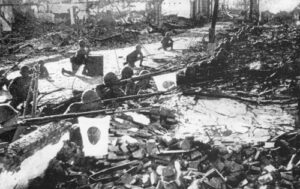
Japanese troops in Shanghai's ruins - There had been ongoing armed confrontations between Japan and China without an official declaration of war since the Japanese attack on Manchuria in 1931, followed by the Japanese invasion of Shanghai in 1932.
- These clashes erupted in July 1937, when the Marco Polo Bridge Incident prompted Japan's offensive. The tenacious Chinese defence at Shanghai halts the Japanese advance, giving the Chinese government much-needed time to relocate important enterprises to the interior.
- To seize the city, the Imperial Japanese Army (IJA) eventually deployed nearly 200,000 troops and several naval vessels and aircraft. Their casualties exceeded the original projections after more than three months of heavy battle.
- The IJA took Dachang, a major stronghold within Shanghai, on 26 October and more forces from Japan arrived at Hangzhou Bay on 5 November. Finally, on 9 November, the NRA launched a mass retreat.
BATTLE OF NANJING AND NANJING MASSACRE
- Building on its hard-won triumph in Shanghai, the IJA conquered Nanjing, the KMT capital city, in December 1937 and Northern Shanxi (September–November 1937). These campaigns featured 350,000 Japanese forces and a far more significant number of Chinese infantry.
- Before the combat began, more than 75% of Nanjing's civilian population had already evacuated, with the remainder seeking refuge in the Nanking Safety Zone, leaving only destitute pariah classes such as Tanka and Duo people behind.
- In 2005, massive controversy and demonstrations in China and Korea were sparked by a history textbook developed by the Japanese Society for History Textbook Reform and approved by the government in 2001.
- It alluded to the Nanjing Massacre and other atrocities like the Manila massacre in the Philippines as "incidents," brushed over the problem of comfort women, and briefly mentioned the deaths of Chinese soldiers and civilians in Nanjing.
- An official Nationalist Government report suggested that an excess of untrained and inexperienced troops was a key reason for the disaster. Still, Tang Shengzhi was made to take much of the responsibility at the time, and later historians condemned him. However, Chiang's decision to protect Nanking is also divisive. Masahiro Yamamoto believes Chiang opted to fight a battle he knew he would lose. Fellow historian Frederick Fu Liu agrees that the move is widely recognised as "the worst strategic blunders of the Sino-Japanese conflict."
- Despite its military achievements, the Nanking Massacre and a series of foreign crises that occurred during and after the fight tarnished Japan's worldwide reputation. Furthermore, as Japan's commanders expected, the loss of Nanking did not push China to yield.
- Nonetheless, bolstered by their success, the Japanese government substituted the moderate terms for peace that they had transmitted to the mediator, Ambassador Trautmann, before the conflict with an exceedingly harsh set of demands that China eventually refused.
CHINESE COUNTER-ATTACK
- With the unprecedented defeat of the Japanese during the 1st Battle of Changsha, Battle of Suixian-Zaoyang, Battle of Zaoyi, and Battle of South Guangxi at the beginning of 1939, the war entered a new phase. These results prompted the Chinese to conduct their first large-scale counter-attack against the IJA in early 1940; nevertheless, this attack was unsuccessful due to the Chinese military-industrial capabilities and inadequate expertise in modern warfare.
- Following that, Chiang could not risk all-out offensive assaults due to his soldiers' inadequate training, under-equipment, and disorganisation, as well as opposition to his leadership inside the Kuomintang and throughout China. He had lost a significant number of his finest trained and equipped men in the Battle of Shanghai, and he was at times at the discretion of his generals, who had considerable autonomy from the central KMT command.
- During the offensive, Hui forces led by generals Ma Hongbin and Ma Buqing repulsed the Imperial Japanese Army and their puppet Inner Mongol forces, preventing Japan's planned push into northwest China.
- During the offensive, Hui forces led by generals Ma Hongbin and Ma Buqing repulsed the Imperial Japanese Army and their puppet Inner Mongol forces, preventing Japan's planned push into northwest China. Ma Fulu, Ma Hongbin's father, had fought against the Japanese during the Boxer Rebellion. At the Battle of Huaiyang, General Ma Biao led the Hui, Salar, and Dongxiang cavalry to victory over the Japanese. During the Boxer Rebellion, Ma Biao fought against the Japanese.
CONCLUSION AND AFTERMATH
- The United States and the Soviet Union ended the war by striking the Japanese with a new weapon (on the part of the United States) and an incursion into Manchuria (on the part of the Soviet Union).
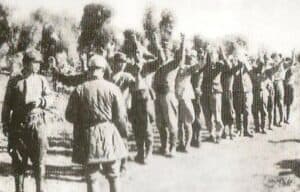
Japanese troops surrender to Chinese troops - On 6 August 1945, the Enola Gay, an American B-29 bomber, exploded the first atomic bomb used in battle on Hiroshima, killing tens of thousands and devastating the city. The Soviet Union renounced its non-aggression treaty with Japan. It invaded the Japanese in Manchuria on 9 August 1945, fulfilling its Yalta Conference vow to attack the Japanese within three months of the war's end in Europe. Three Soviet army groups launched the attack.
- In less than two weeks, the Soviets defeated the Kwantung Army, the principal Japanese fighting force, consisting of over a million men but lacking significant armour, artillery, or air support. On 15 August 1945, Japanese Emperor Hirohito formally surrendered to the Allies.
- The eleventh hour of the eleventh day of the eleventh month was chosen as a homage to the 1918 Armistice because "nine" is a Chinese homophone for "long-lasting."

